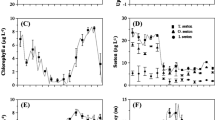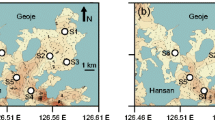Abstract
We examined the relation of RNA/DNA ratios to growth for three size groups of the tropical scallop Euvola ziczac maintained in suspended culture at 8, 21 and 34 m in depth in the Golfo de Cariaco, Venezuel. Various growth parameters indicated that production decreased with depth. This was more likely due to a decrease in seston quality with depth than to temperatures or seston abundance (which were similar at the various depths studied). The RNA/DNA ratio was correlated with the G-index of muscle growth for juveniles (r 2=0.55). A much weaker correlation was observed for the maturing scallops (r 2=0.18), probably because of the interaction between reproductive and somatic growth. In fully mature scallops, somatic growth was negligible and the RNA/DNA ratios appeared to be inversely related to the level of physiological stress of the scallops. Whereas RNA/DNA ratios are difficult to interpret for maturing E. ziczac, because an increased ratio can be due to either increased gonadal or somatic growth, they are useful in predicting growth in juveniles and physiological stress in fully mature scallops.
Similar content being viewed by others
References
Alfonsi C, Nusetti O, Pérez J (1995) Heterozygosity and metabolic efficiency in the scallop Euvola ziczac (L., 1758). J Shellfish Res 14: 389–393
Anger K, Hirche H-J (1990) Nucleic acids and growth of larval and early juvenile spider crab, Hyas aranues. Mar Biol 105: 403–411
Barber BJ, Blake NJ (1991) Reproductive physiology. In: Shumway SE (ed) Scallops: biology, ecology and aquaculture. Developments in Aquaculture and Fisheries Science. Vol. 21. Elsevier Science Publishers, Amsterdam, pp 377–328
Bonardelli J, Himmelman JH (1995) Examination of assumptions critical to body component indices: application to the giant scallop Placopecten magellanicus. Can J Fish aquat Sciences 52: 2457–2469
Buckley LJ (1984) RNA-DNA ratio: an index of larval fish growth in the sea. Mar Biol 80: 291–298
Buckley LJ, Lough RG (1987) Recent growth, biochemical composition, and prey field of larval haddock (Melanogrammus aelglefinus) and Atlantic cod (Gadus morhua) on Georges Banks. Can J Fish aquat Sciences 44: 14–25
Bulow FJ (1970) RNA-DNA ratios as indicator of recent growth rates of fish. J Fish Res Bd Can 27: 2343–2349
Bulow FJ (1987) RNA-DNA ratios as indicator of growth in fish: a review. In: Summerfelt R, Gordon E (eds) The age and growth of fish. State University Press Ames, Iowa pp 45–64
Clarke A, Rodhouse PG, Holmes L, Pascoe PL (1989) Growth rate and nucleic acid ratio in cultured cuttlefish Sepia officinales (Mollusca: Cephalopoda). J exp mar Biol Ecol 33: 229–240
Clemmensen CM (1987) A highly sensitive method to determine RNA and DNA content in individual marine fish larvae. Int Counc Explor Sea Comm Meet (Oceanogr biol Comm) L: 22: 1–12
Coronado MC, Gonzalez P, Pérez J (1991) Genetic variation in Venezuelan molluscs: Pecten ziczac and Lyropecten nodosus (Pectinidae). Caribb J Sci 27: 71–74
Dubois M, Gilles J, Hamilton J, Reber P, Smith F (1956) Colorimetric method for determination of sugars and related substances. Analyt Chem 28: 2350–2356
Epp J, Bricelj M, Malouf R (1988) Seasonal partitioning and utilization of energy reserves in two age classes of the bay scallop Argopecten irradians irradians (Lamarck). J exp mar Biol Ecol 121: 112–136
Frantzis A, Grémare A, Vétion G (1992) Grwoth rates and RNA/DNA ratios in Paracentrotus lividus (Echinodermata: Echinoidea) fed on benthic macrophytes. J exp mar Biol Ecol 156: 125–138
Frantzis A, Grémare A, Vétion G (1993) Taux de croissance et rapports de ARN/ADN chez le bivalve dépositivore Abra ovata nouri á partir de différents détritus. Oceanol Acta 16: 303–313
Freites L, Vélez A, Vera B, Lodeiros C (1995) Efecto de la densidad sobre el crecimiento y la supervivencia de juveniles de Euvola (Pecten) ziczac (L.) bajo condiciones de cultivo suspendido. Cienes mar 21: 361–372
Gnaiger E, Bitterlich G (1984) Proximate biochemical composition and caloric content calculated from elemental CHN analysis: a stoichiometric concept. Oecologia 62: 289–298
Guderley GHE, Rojas FR, Nusetti O (1995) Metabolic specialization of mitochondria from scallop phasic muscles. Mar Biol 122: 409–416
Haines TA (1973) An evaluation of RNA-DNA ratio as a measure of long-term growth in fish population. J Fish Res Bd Can 30: 195–199
Holland DL, Hannant PJ (1973) Addendum to a micro-analytical scheme for the biochemical analysis of marine invertebrate larvae. J mar biol Ass UK 53: 833–838
Imai T (1977) Aquaculture in shallow seas: progress in shallow sea culture. National Technical Information Service, Springfield, Va, USA, pp 261–264
Karsten U, Wollenberger A (1977) Improvement in the ethidium bromide method for direct fluorometric estimation of DNA and RNA in cell and tissue homogenates. Analyt Biochem 77: 464–470
Kenchington ELR (1994) Spatial and temporal variation in adductor muscle RNA/DNA ratio in sea scallops (Placopecten magellanicus) in the Bay of Fundy, Canada. J Shellfish Res 13: 19–24
Lodeiros C, Freites L, Vélez A (1992) Necrosis bacilar en larvas del bivalvo Pecten ziczac (Linneo, 1758) causada por una Pseudomonas sp. Acta cient Venez 43: 154–158
Lodeiros CJ, Himmelman JH (1994) Relations among environmental conditions and growth in the tropical scallop Euvola (Pecten) ziczac (L.) in suspended culture in the Golfo de Cariaco, Venezuela. Aquaculture, Amesterdam 119: 345–358
Lodeiros C, Himmelman JH, Subero S, Freites L, Figueroa D, Pérez C (1993) Influencia de la produndidad en el crecimiento somático y reproductivo de la vieira Euvola ziczac bajo condiciones de cultivo suspendido. Memorias V Congreso Latinoaméricano de Ciencias del Mar, Universidad de Baja California Sur, LaPaz, Mexico, p 30
Lowry O, Rosebbrough N, Farr A, Randall R (1951) Protein measurement with the Folin phenol reagent. J biol Chem 193: 265–275
Mackie LA, Ansell AD (1993) Differences in reproductive ecology in natural and transplanted populations of Pecten maximus: evidence for the existence of separate stocks. J exp mar Biol Ecol 169: 57–75
Martinez G, Torres M, Uribe E, Diaz M, Pérez H (1992) Biochemical compositions of broodstock and early juvenile Chilean scallops, Argopecten purpuratus Lamarck, held in two different environments. J Shellfish Res 11: 307–313
Mayrand E, Pellerin-Massicotte J, Vincent B (1994) Small scale variability of biochemical indices of growth in Mya arenaria (L.). J Shellfish Res 13: 119–205
Moigis AG (1986) Variación anual de la productividad primaria del fitoplancton en el Golfo y en la Fosa de Cariaco, Venezuela. Boln Inst oceanogr Univ Oriente (Cumaná, Venezuela) 25: 115–126
Moss SM (1994) Use of nucleic acids as indicators of growth in juvenile white shrimp, Penaeus vannamei. Mar Biol 120: 359–367
Nusetti O, Morales D (1988) Crecimiento de algunos tejidos del mejillón Perna perna (L. 1758): Composicin de ADN, relaciones ARN/ADN y reservas energéticas. Acta cient Venez 39: 289–293
Okuda T, Benitez-Alvarez J, Bonilla J, Cedeño G (1978) Caracteristicas hidrográficas del Golfo de Cariaco, Venezuela. Boln Inst oceanogr Univ Oriente (Cumaná, Venezuela) 17: 69–88
Pease AK (1976) Studies of the relationship of RNA/DNA ratios and the rate of protein synthesis to growth in the oyster, Crassostrea virginica. Tech Rep Fish mar Serv Can 622: 1–88
Ricker WE (1979) Growth rates and models. In: Hoar W, Randall LD, Brett J (eds) Fish physiology, 8: bioenergetics and growth. Academic Press, New York, pp 677–743
Rios EC (1985) Seashells of Brazil. Fundação do Rio Grande, Fundação Universidade do Rio Grande, Rio Grande, Brazil
Robbins I, Lubet P, Besnar Y (1990) Seasonal variations in the nucleic acid content and RNA/DNA ratio of the gonad of the scallop Pecten maximus. Mar Biol 105: 191–195
Rojas L, Azuaje O, Vélez A (1988) Efecto convinado de la ración y la densidad larvaria sobre la supervivencia y crecimiento de larvas de Pecten ziczac (Linné, 1758). Boln Inst Oceanogr Univ Oriente (Cumaná, Venezuela) 27: 57–62
Shecherban S (1992) Relationship between the RNA/DNA ratio, relative protein content, and dry weight of mussels in a short experiment. Hydrobiol J 28: 69–74
Simpson JG, Griffiths RC (1971) Upwelling and biological production in the Gulf of Cariaco, Venezuela. Vol. 2. Ministerio de Agriculturay Cría, Series Recursos y Explotación Pesqueros, Caracas
Strickland JDH, Parson TR (1972) A practical handbook of seawater analysis. No. 167 (2nd edn) Fisheries Research Board of Canada, Ottawa
Sutcliffe WH (1965) Growth estimates from ribonucleic acid content in some small animals. Limnol Oceanogr 10: 253–258
Sutcliffe WH (1970) Relationship between growth rate and ribonucleic acid concentration in some invertebrates. J Fish Res Bd Can 27: 606–609
Taylor A, Venn T (1979) Seasonal variations in weight and biochemical composition of tissues of the queen scallop Chlamys opercularis from the Clyde Sea Area. J mar Biol Ass UK 59: 605–621
Vélez A, Alifa E, Azuaje O (1990) Induction of spawning by temperature and serotonin in the hermaphroditic tropical scallop, Pecten ziczac. Aquaculture, Amsterdam 84: 307–313
Vélez A, Alifa E, Freites L (1993) Inducción de la reproducción en la vieira Pecten ziczac. I. Maduración y desove. Caribb J Sci 29: 209–213
Vélez A, Freites L (1993) Cultivo de “semillas” de la vieira Pecten ziczac bajo condiciones ambientales controladas. Mem IV Congreso Ciencias del Mar, Serie Ocacional No. 2, Facultad de Ciencias del Mar, Universidad Católica del Norte, Coquimbo, Chile, pp 311–317
Vélez A, Freites L, Himmelman JH, Senior W, Marín N (1995) Growth of the tropical scallop, Euvola (Pecten) ziczac in bottom and suspended culture in the Golfo de Cariaco, Venezuela. Aquaculture, Amsterdam 136: 257–276
Vélez A, Lodeiros C (1990) El cultivo de moluscos en Venezuela. In: Hernandez A (ed) Cultivo de moluscos en America Latina. Red Regional de Entidades y Centros de Acuicultura de América Latina. Centro Interacional de Investigaciones para el Desarrollo Canada, Bogotá, pp 345–369
Vélez A, Sotillo F, Pérez J (1987) Variación estacional de la composición química de los pectínidos Pecten ziczac y Lyropecten nodosus. Boln Inst Ocenogr Univ Oriente (Cumaná, Venezuela) 26: 67–72
Ventilla RF (1982) The scallop industry in Japan. Adv mar Biol 20: 310–382
Vera B (1988) Algunos aspectos que influyen sobre la fijación de la vieira Pecten ziczac. Mems Soc Cienc nat La Salle 48: 103–110
Waller TR (1991) Evolutionary relationships among commercial scallops (Mollusca; Bivalvia; Pectinidae). In: Shumway SE (ed) Scallops: biology, ecology and aquaculture. Developments in aquaculture and fisheries science. Vol. 21. Elsevier Science Publishers B.V., New York, pp 1–73
Wilkens LA (1981) Neurobiology of scallop. I. Starfish-mediated escape behaviour. Proc R Soc (Ser B) 211: 341–372
Wilkens LA, Ache BW (1977) Visual responses in the central nervous system of the scallop Pecten ziczac. Experientia 33: 1338–1339
Wright D, Hetzel E (1985) Use of RNA/DNA ratios as an indicator of nutritional stress in American oyster Crassostrea virginica. Mar Ecol Prog Ser 25: 199–206
Zar JH (1984) Biostatistical analysis. Prentice Hall, Englewood Cliffs, NJ
Author information
Authors and Affiliations
Additional information
Communicated by R.J. Thompson, St. John's
Rights and permissions
About this article
Cite this article
Lodeiros, C.J.M., Fernández, R.I., Bonmati, A. et al. Relation of RNA/DNA ratios to growth for the scallop Euvola (Pecten) ziczac in suspended culture. Marine Biology 126, 245–251 (1996). https://doi.org/10.1007/BF00347449
Received:
Accepted:
Issue Date:
DOI: https://doi.org/10.1007/BF00347449




